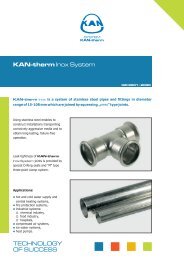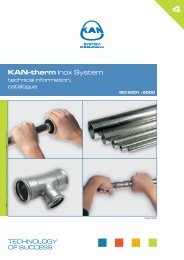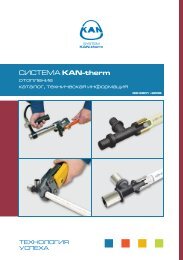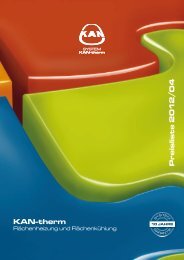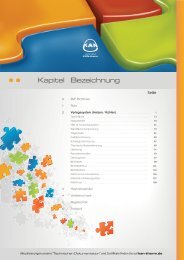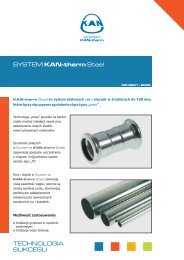KAN-therm Press System
KAN-therm Press System
KAN-therm Press System
You also want an ePaper? Increase the reach of your titles
YUMPU automatically turns print PDFs into web optimized ePapers that Google loves.
<strong>KAN</strong>-<strong>therm</strong> <strong>Press</strong> <strong>System</strong> - technical information<br />
<strong>KAN</strong>-<strong>therm</strong> <strong>Press</strong> <strong>System</strong> - Z type pipe <strong>therm</strong>al elongation compensation<br />
A - compensation arm length (expansion compensation length)<br />
SP - slidable point (enables movement along pipe axis only)<br />
FP - fixed point (prevents pipeline from moving)<br />
L - pipeline initial length<br />
ΔL - pipeline <strong>therm</strong>al elongation<br />
For compensation arm dimensioning, L1 and L2 sum is taken as substitute length L Z =L1+L2, and for this L Z length substitute<br />
elongation ΔL z is determined on the basis of Table 1. Next, compensation arm A Z length (expansion compensation length) is<br />
determined on the basis of Table 2.<br />
<strong>KAN</strong>-<strong>therm</strong> <strong>Press</strong> <strong>System</strong> - U type pipe <strong>therm</strong>al elongation compensation<br />
A - compensation arm length (expansion compensation length)<br />
SP - slidable point (enables movement along pipe axis only)<br />
FP - fixed point (prevents pipeline from moving)<br />
L - pipeline initial length<br />
ΔL - pipeline <strong>therm</strong>al elongation<br />
W - U shape compensator width<br />
For compensation arm dimensioning (in case where FP doesn't exist on W length), half of L1 and L2 sum is taken as substitute<br />
length L Z =(L1+L2)/2, and for this L Z length substitute <strong>therm</strong>al elongation ΔL z is determined on the basis of Table 1. Next,<br />
compensation arm A Z length (expansion compensation length) is determined on the basis of Table 2.<br />
A - compensation arm length (expansion compensation length)<br />
SP - slidable point (enables movement along pipe axis only)<br />
FP - fixed point (prevents pipeline from moving)<br />
L - pipeline initial length<br />
ΔL - pipeline <strong>therm</strong>al elongation<br />
W - U shape compensator width<br />
In the case of placing fixed point FP on a segment constituting compensator width W, for compensation arm dimensioning a<br />
higher value L1 or L2: is taken as substitute length L Z =max(L1, L2), and for this L Z length substitute <strong>therm</strong>al elongation ΔL z is<br />
determined on the basis of Table 1. Next, compensation arm A Z length (expansion compensation length) is determined on the<br />
basis of Table 2.<br />
Compensator width W has to provide free operation of L1 and L2 segments and allow for possible pipe insulation thickness<br />
and assembly conditions.<br />
W ≥ 2¤ t ins + ΔL1 + ΔL2 + S min<br />
t ins - insulation thickness<br />
ΔL1, ΔL2 - L1 and L2 segments <strong>therm</strong>al elongation<br />
S min - minimum length resulting from elbow build-over or pipe bending.<br />
Width W should be minimized in the case when width W exceeds 10% of L1 or L2 value, U-shape compensator with a fixed<br />
point FP should be calculated as Z type compensator taking into consideration width W and a higher value of L1 and L2.<br />
Minimum pipe bending radius R min = 5 D Ex (it is not recommended to bend pipes of external diameter above 32 mm)<br />
D Ex - pipe external diameter.<br />
- 6 -




